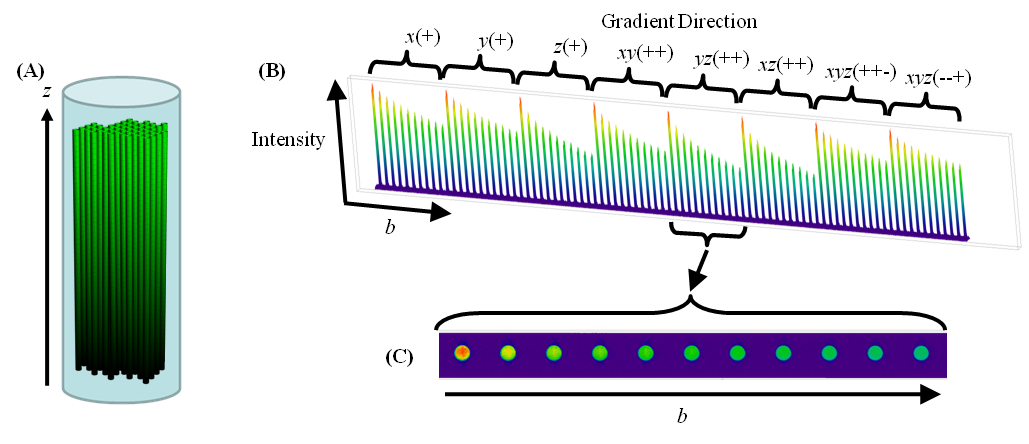orals 5th Asia-Pacific NMR Symposium 2013
DTI of a macroscopically aligned lyotropic hexagonal phase templated hydrogel (#102)
Translational diffusion is the most fundamental form of molecular transport and reports on the local environment and whether the diffusing molecule is in any association state.1,2 Lyotropic liquid crystal (LLC) materials like LLC templated hydrogels,3 have a wide range of applications (from catalyst materials to drug delivery).4 LLC phases are typically present as a powder distribution of director orientations, but macroscopically aligned phases can be prepared (e.g., alignment in magnetic fields).5 Characterization of diffusion is important since most of the applications of these materials depend on transport. The anisotropy of self-diffusion and its time dependence provide information of the alignment and defect length scale in materials such as LLC templated hydrogels (e.g., LLC gels6, 7).
Diffusion tensor imaging (DTI) was performed on a macroscopically aligned lyotropic hexagonal phase templated hydrogel. The non-ionic surfactant decaethylene glycol monododecyl ether (C12EO10) was used to template the polyethylene glycol diacrylate (PEG-DA) hydrogel.8 The self-diffusion of water was found to be time independent (up to 3 s) via high resolution diffusion measurements (i.e., non-imaging) shortly after preparation.8 DTI measurements some time after storage (~456 days) showed that the sample is still highly anisotropic (Figure 1).
 Figure 1: Diffusion tensor imaging of a macroscopically aligned lyotropic hexagonal phase templated hydrogel after storage. (A) Schematic of the alignment of the hexagonal phase in the templated hydrogel. (B) MR images for all b-values (i.e., the term in the diffusion equation including all delays and gradient parameters) and the gradient directions indicated. There are 11 b-values per direction. The + and – following the axis label indicate the positive or negative gradient direction. The images are for an axial slice (voxel size: 0.196 mm × 0.196 mm × 0.5 mm (slice thickness), diffusion time: 70 ms). (C) Images of the axial slice for one of the directions measured.
Figure 1: Diffusion tensor imaging of a macroscopically aligned lyotropic hexagonal phase templated hydrogel after storage. (A) Schematic of the alignment of the hexagonal phase in the templated hydrogel. (B) MR images for all b-values (i.e., the term in the diffusion equation including all delays and gradient parameters) and the gradient directions indicated. There are 11 b-values per direction. The + and – following the axis label indicate the positive or negative gradient direction. The images are for an axial slice (voxel size: 0.196 mm × 0.196 mm × 0.5 mm (slice thickness), diffusion time: 70 ms). (C) Images of the axial slice for one of the directions measured.
- Price, W. S., NMR Studies of Translational Motion. Cambridge University Press: Cambridge, 2009.
- Callaghan, P. T. Aust. J. Phys. 1984, 37, 359-387.
- Clapper, J. D.; Guymon, C. A. Macromolecules 2007, 40, 1101-1107.
- Gin, D.; Pecinovsky, C.; Bara, J.; Kerr, R. Struct. Bond. 2008, 128, 181-222.
- Tiddy, G. J. T. Phys. Rep. 1980, 57, 1-46.
- Kleinschmidt, F.; Hickl, M.; Saalwachter, K.; Schmidt, C.; Finkelmann, H. Macromolecules 2005, 38, 9772-9782.
- Åslund, I.; Cabaleiro-Lago, C.; Söderman, O.; Topgaard, D. J. Phys. Chem. B 2008, 112, 2782-2794.
- Willis, S. A.; Dennis, G. R.; Zheng, G.; Price, W. S. React. Funct. Polym. 2013, 73, 911-922.